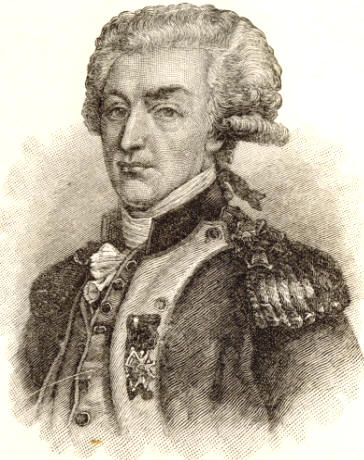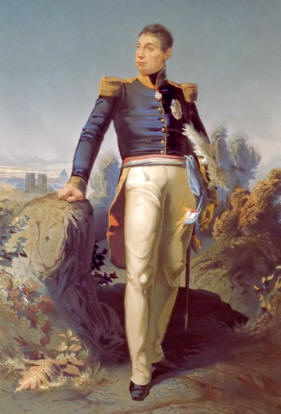General Marquis de Lafayette
|
|
This Site:
|
[General Lafayette Biography] [General Lafayette's Memoirs] [Lafayette's Eulogy]
Lafayette Arrives in South Carolina, Joins the Continental Army
Howe Tries to Capture LafayetteTo restrain British foragers and marauders, who were plundering the country for some distance around Philadelphia in the spring of 1778, Washington sent him out from Valley Forge, with about 2,100 men and five pieces of artillery, to cut off all communication between Philadelphia and the country, and to obtain information concerning a rumored intention of the British to evacuate that city. Lafayette crossed the Schuylkill, and took post at Barren Hill, about half-way between Valley Forge and Philadelphia, occupying the Lutheran church there as headquarters. General Howe sent General Grant to make a secret night march to gain the rear of the marquis (May 20), and the next morning Howe marched with about 6,000 men, commanded by Clinton and Knyphausen, to capture the young Frenchman and send him to England. The marquis outgeneralled the British, though they surprised him, and escaped across the Schuylkill. Howe was disappointed, for he was about to depart for England under a partial cloud of ministerial displeasure, and he hoped to close his career in America by some brilliant act. Lafayette Secures French Support for the American RevolutionAfter a short winter passage from Boston to Brest, in February, 1779, Lafayette joined his family and friends in his native land. His offence in sailing for America in defiance of the King's command was atoned for by a week's exile to Paris, and confinement in the house of his father-in-law. He was then received at Versailles, when the King gently reprimanded him, while the Queen eagerly sought information concerning America from his own lips. His fame made him the admired of Court society as well as of the populace of the French capital. The young marquis observed with alarm that everybody was talking of peace, while America was struggling with armed champions of royalty, and he felt that the independence of the colonies was in peril. With great earnestness he pleaded for aid for the Americans, and was successful. Lafayette Imprisoned in FranceIn 1784 he again visited the United States, and was everywhere received with tokens of affection and respect. He became a member of the Notables at Paris in 1787, when he boldly demanded the convocation of the States-General, consisting of three orders—namely, the clergy, nobility, and commons—representatives of the whole nation. They had not met since 1614, a period of 173 years. The King (Louis XVI.) convened them on May 6, 1789. There were 308 ecclesiastics, 285 nobles, and 621 deputies of the third estate, or the "common people." In July Lafayette was appointed commander-in-chief of the National Guard. When the abolition of titles was decreed, he dropped his, and was known only as General Lafayette. He resigned his command in 1790, and in 1792 commanded one of the armies sent to guard the frontiers of France against the forces of monarchs alarmed by the republican demonstrations in France. When the fierce Jacobins seized power the conservative Lafayette was denounced and his arrest decreed. He crossed the frontier, intending to take refuge in Holland. The Austrians seized him, and confined him in a dungeon five years. For a long time no intelligence of him reached his friends. Meanwhile his wife had been imprisoned at Paris during the "Reign of Terror," but had been set at liberty on the downfall of Robespierre. She hastened to Vienna, obtained a personal interview with the Emperor, and gained permission to share the captivity of her husband. Great exertions were made in Europe and America to obtain his release, but in vain, until Bonaparte, at the head of an army, demanded his release. He was set at liberty Aug. 25, 1797. Towards the end of 1799 he returned to his estate of La Grange, 40 miles from Paris. Bonaparte tried to bribe him with offered honors to enter public life again as senator. He refused with disdain; and when the vote for making Bonaparte first consul for life was taken, Lafayette voted no, and told the ambitious general so in a letter, which ended their intercourse. When Bonaparte became Emperor, Lafayette took a seat in the Chamber of Deputies; and this stanch champion of constitutional government refused the offered bauble of a peerage. After the battle of Waterloo, touched with sympathy for the fallen monarch, he offered him facilities for escaping to America; but the Emperor, who could not forgive Lafayette's former opposition, refused to accept the offer, and became a prisoner on St. Helena. In the French legislature Lafayette's voice was always in favor of liberal measures. In 1824 the Congress of the United States requested President Monroe to invite Lafayette to America as a guest of the republic. He came, but declined the offer of a ship. With his son and a private secretary he landed in New York, August 15, 1824, visited in succession the whole twenty-four States, and was everywhere received with demonstrations of love and respect. Between Washington and Lafayette there had grown up a strong mutual affection during their intercourse in the scenes of the old war for independence. When at the seat of government in October, 1824, while on his visit to the United States, the marquis was conducted to Mount Vernon by George Washington Parke Custis, the adopted son of Washington, with whom George W. Lafayette had lived in the mansion of the great patriot while Lafayette was an exile from France and in a prison. He was conveyed from the capital in a barge, accompanied by his son; John C. Calhoun, Secretary of War, and Mr. Custis; and at the shore at Mount Vernon he was received by Lawrence Lewis, Washington's favorite nephew, and the family of Judge Bushrod Washington, who was then absent on official business. After visiting the mansion, where, forty years before, he took his last leave of the beloved patriot, the company proceeded to the tomb (the old one, on the brow of the hill), where Custis presented the marquis with a ring containing a lock of Washington's hair. He received it with emotion. The door of the vault was opened, and there were displayed the leaden caskets which contained the coffins of Washington and his wife, decorated with flowers. Lafayette entered, kissed the casket, and reverently retired. Lafayette spent fourteen months in America. He visited Andrew Jackson at the "Hermitage," and on his return to Washington his sixty-eighth birthday was celebrated at the White House. He sailed for Europe September 7, 1825, in the frigate Brandywine. Death of LafayetteDuring the revolution of 1830, that drove Charles X. from the throne, Lafayette was made commander-in-chief of the National Guard. He sacrificed his own republican preferences for the sake of peace and order, and placed Louis Philippe on the throne. He died the acknowledged chief of the constitutional party on the continent of Europe, May 20, 1834. He received a magnificent public funeral, when his remains were conveyed to their resting-place in the cemetery of Piepus. The monument is about 8 feet square, with appropriate inscriptions in French. The cross seen in the picture stands over the grave of another. |
|
|
||
|
|
Site Copyright 2003-2018 Son of the South. For Questions or comments about this collection, contact: paul@sonofthesouth.net |
|
|
Are you Scared and Confused? Read My Snake Story, a story of hope and encouragement, to help you face your fears. |
||
 Lafayette,
MARIE JEAN PAUL ROCH YVES GILBERT MOTIER, MARQUIS DE, patriot; born
in Cavanac, Auvergne, France, September 6, 1757. Left an heir to an
immense estate at the age of thirteen years, he received the best
education that could be obtained, and at sixteen married a
grand-daughter of the Duke de Noailles. He entered the army as a
captain of dragoons, and in the summer of 1776 he heard of the
struggles of the English-American colonies. He immediately resolved
to aid them. When he and other French officers were ready to embark
for America (1777), he was informed that the credit of the
Lafayette,
MARIE JEAN PAUL ROCH YVES GILBERT MOTIER, MARQUIS DE, patriot; born
in Cavanac, Auvergne, France, September 6, 1757. Left an heir to an
immense estate at the age of thirteen years, he received the best
education that could be obtained, and at sixteen married a
grand-daughter of the Duke de Noailles. He entered the army as a
captain of dragoons, and in the summer of 1776 he heard of the
struggles of the English-American colonies. He immediately resolved
to aid them. When he and other French officers were ready to embark
for America (1777), he was informed that the credit of the
 The
party landed near Georgetown,
The
party landed near Georgetown,